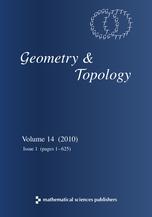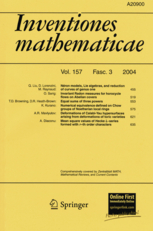| 2014 |
 |
|  |

|
By a result of Eliashberg, every symplectic filling of a three-dimensional contact connected sum is obtained by performing a boundary connected sum on another symplectic filling. We prove a partial generalization of this result for subcritical contact surgeries in higher dimensions: given any contact manifold that arises from another contact manifold by subcritical surgery, its belt sphere must be nullhomologous in any semipositive filling, and in dimension five, it must be nullhomotopic in any symplectically aspherical filling. The proof is based on disk-filling techniques with families of Legendrian open books (so-called "LOBs") as boundary conditions. We also illustrate the method by giving a new proof of the Eliashberg-Floer-McDuff theorem on symplectic fillings of spheres, which may be seen as a special case of our main result.
|
|
| 2013 |
 |
|  |

|
We show that the presence of a plastikstufe induces a certain degree of flexibility in contact manifolds of dimension 2n+1>3. More precisely, we prove that every Legendrian knot whose complement contains a "nice" plastikstufe can be destabilized (and, as a consequence, is loose). As an application, it follows in certain situations that two non-isomorphic contact structures become isomorphic after connect-summing with a manifold containing a plastikstufe.
|
|
|  |

|
For contact manifolds in dimension three, the notions of weak and strong symplectic fillability and tightness are all known to be inequivalent. We extend these facts to higher dimensions: in particular, we define a natural generalization of weak fillings and prove that it is indeed weaker (at least in dimension five),while also being obstructed by all known manifestations of "overtwistedness". We also find the first examples of contact manifolds in all dimensions that are not symplectically fillable but also cannot be called overtwisted in any reasonable sense. These depend on a higher-dimensional analogue of Giroux torsion, which we define via the existence in all dimensions of exact symplectic manifolds with disconnected contact boundary.
|
|
| 2012 |
 |
|  |

|
This paper begins the study of relations between Riemannian geometry and contact topology in any dimension and continues this study in dimension 3. Specifically we provide a lower bound for the radius of a geodesic ball in a contact manifold that can be embedded in the standard contact structure on Euclidean space, that is on the size of a Darboux ball. The bound is established with respect to a Riemannian metric compatible with an associated contact form. In dimension three, it further leads us to an estimate of the size for a standard neighborhood of a closed Reeb orbit. The main tools are classical comparison theorems in Riemannian geometry. In the same context, we also use holomorphic curves techniques to provide a lower bound for the radius of a PS-tight ball.
|
|
| 2011 |
 |
|  |

|
Helmut Hofer introduced in '93 a novel technique based on holomorphic
curves to prove the Weinstein conjecture. Among the cases where these
methods apply are all contact 3-manifolds (M,ξ) with
π2(M) ≠ 0. We modify Hofer's argument to
prove the Weinstein
conjecture for some examples of higher dimensional contact manifolds.
In particular, we are able to show that the connected sum with a real
projective space always has a closed contractible Reeb orbit.
|
|
